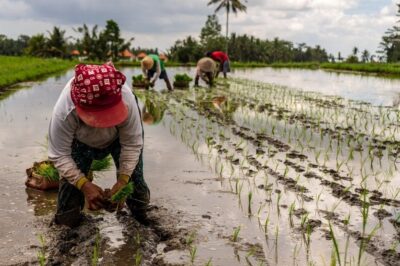Pakistan experienced a historic surge in rice exports. Previously, exports reached a high of 4.8 million tons, valued at about $2.5 billion in FY2021-22. In the first 11 months of FY2022-23, this figure rose to an estimated 5.6 million tons, worth $3.5 billion. The increased global demand for rice was influenced by factors like India’s export ban. There are questions about the viability of this growth. Despite these concerns, there is a clear ambition to boost exports further. This is evident from the expansion of rice cultivation and industry projections.
Pakistan’s rice cultivation area has dramatically expanded by 40% over the last 12 fiscal years.
This expansion has resulted in a corresponding 46% increase in production. These estimates are based on the USDA’s projections for FY2024. This growth aligns with the government’s efforts to attract foreign investments in agriculture. Initiatives like the Special Investment Facilitation Council (SIFC) are part of this strategy. Furthermore, Shehzad Ali Malik, a leading stakeholder, also announced the industry’s projection of hitting $10 billion in exports by 2030.
Climate-Resilient Rice Production
These statistics provide a welcome relief for the dwindling foreign exchange reserves. However, the ecological sustainability of the entire enterprise is a serious concern.
Our rice production is drowning in inefficiency. Rice fields are guzzling 1,200-2,000mm of water, while the crop only needs 700mm.
This excess, combined with low yields, results in low water productivity. Our water productivity is just 0.23 kg of rice per cubic meter of water. In comparison, the global average is significantly higher at 0.79 kg per cubic meter.
Compounding this issue is Pakistan’s dwindling water storage capacity. Dams are choked with sediment, and outdated billing policies for freshwater extraction encourage wasteful water practices. Given the grim prospects of augmenting water-storage capacity and the likelihood of worsening water scarcity, Pakistan’s best course of action is to manage existing water resources equitably and efficiently. Reflecting this realization, the government often imposes bans on paddy cultivation, especially in Sindh. These bans are in response to concerns about water-logging, salinity, and drought.
India’s Rice Cultivation Regulations
The Indian government also bans rice cultivation in dark zones where water beds are endangered. While well-intentioned, these blanket bans seldom work, as they directly threaten the livelihoods of farmers. A more effective approach is to incentivize farmers to adopt water-saving techniques through subsidies, public-private partnerships, and training programs.
This necessitates increasing water-use efficiency to reduce stress on the reservoirs while simultaneously enhancing crop yield and quality by preventing water logging and salination. All combined, the end goal is to increase water productivity, that is, the amount of value produced per unit volume of water consumed. It also offers significant cuts in the energy costs spent pumping the water. The overall effect is an economic benefit for the farmer and the long-term sustainability of the practice.
Also Read: Pakistan, Türkiye, Azerbaijan forge alliances
Sustainable Water Use in Paddy Cultivation
To achieve this, several promising methods offer a roadmap for Pakistan to optimize water use in rice cultivation. For example, the System of Rice Intensification (SRI) is a holistic approach that combines several practices, including using younger seedlings, wider spacing, and intermittent irrigation, to enhance rice yields while reducing water consumption. In India, SRI practices resulted in a 58% yield increase with 16% less water compared to conventional methods.
Alternate Wetting and Drying (AWD), a key component of SRI, is a simple yet effective technique that can reduce water consumption by 30% or more without sacrificing yields. In Thailand, AWD increased grain yield by 15% in the wet season and 7% in the dry season, with a 46% improvement in water productivity in the wet season and 77% in the dry season. By strategically timing irrigation cycles to allow the field to dry intermittently, farmers can conserve water, too, while maintaining optimal growing conditions.
Similarly, Direct Seeding of Rice (DSR) eliminates the need for transplanting seedlings, saving water used in land preparation and early irrigation. Dry direct seeding can save up to 40% of water compared to flooded irrigation of transplanted rice. In India, DSR resulted in a 20% water savings in a farmer participatory action research program. Controlled Irrigation (CI) or Wet Irrigation (WI) offers more precise approaches, carefully managing water levels throughout the growing season to match the crop’s specific needs. Furthermore, a crucial aspect of water management is irrigation scheduling. Research suggests that irrigating fields a few days after the disappearance of ponded water (DADPW) can be as effective as continuous flooding, leading to a 23% reduction in water use.
Water Replenishment
In addition to these on-farm techniques, addressing conveyance losses in irrigation canals and promoting rainwater harvesting through gravity wells can significantly recharge depleted water tables. By lining canals and implementing efficient water delivery systems, Pakistan can minimize water wastage during transportation. Furthermore, constructing gravity wells can capture and store rainwater, allowing it to percolate into the ground and replenish aquifers. These combined measures offer a sustainable solution to enhance water availability for rice cultivation and other agricultural needs.
Pakistan’s policymakers must seize this opportunity to revolutionize the nation’s rice production, transforming it into a model of water efficiency and sustainability. By incentivizing proven water-saving techniques like SRI, AWD, and DSR, investing in irrigation infrastructure upgrades, and prioritizing research into drought-resistant rice varieties, Pakistan can not only conserve its precious water resources but also boost agricultural productivity and ensure food security. Empowering farmers through education and extension services, coupled with data-driven policies, will be crucial in achieving this transformation. The time for bold action is now; the future of Pakistan’s rice production and its agricultural resilience hangs in the balance.

International Relations student with solid academic basis in Diplomatic Relations, International Law and Intercultural Communication. Her writings focus on international relations, feminism and current trends.







